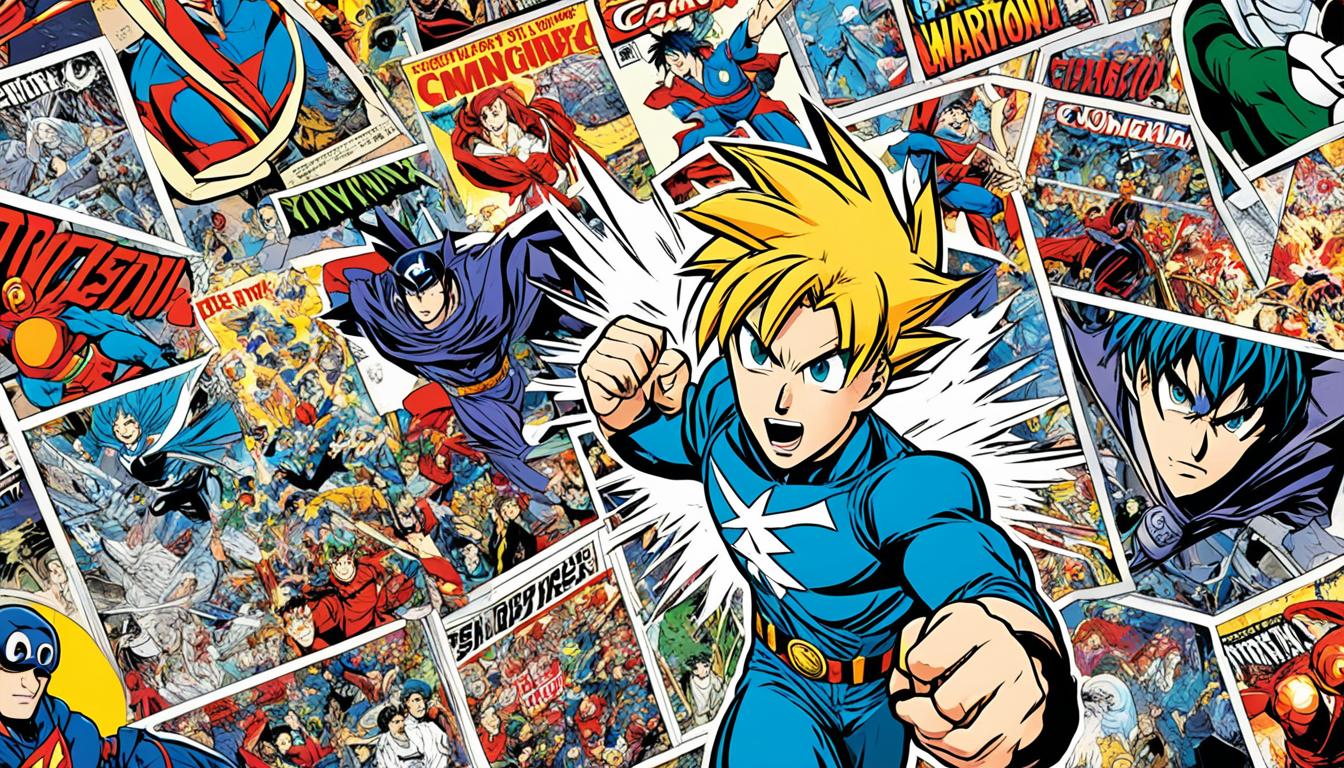Anime series like Dragon Ball Z and Naruto are super popular worldwide. They show unique stories and Japanese culture with cool art. But, remember, not all things in anime and manga are exactly like real life in Japan.
Characters in anime often look very different from real Japanese people. They might be tall, thin, and have big eyes. This is pretty different from how most Japanese people actually look. Anime characters might also act loud and brave, but in real life, many Japanese people are quiet and reserved.
Anime can also make Japanese schools seem more wild than they really are. Anime students can have crazy hair and wear trendy clothes. But real Japanese schools have strict rules about how students can dress and look.
Even with these differences, anime and manga show a lot about Japan. Early works like Hokusai’s “Manga” show Japan’s rich history and different kinds of people. They give us a window into the past.
Some say the look of manga characters has changed because of American influence. When America occupied Japan, it brought comic books. This might have changed how artists drew characters. Also, many anime talk about important issues and show what makes Japan special.
Key Takeaways:
- Anime and manga offer a unique perspective on Japanese society, but not all aspects portrayed reflect the realities of Japanese culture.
- Physical appearances in anime often deviate from the average features of Japanese citizens.
- Portrayals of Japanese students in anime do not align with the strict dress code and conservative nature of actual Japanese schools.
- Early manga provides a more accurate representation of Japanese society compared to modern manga.
- The influence of American rule during the American invasion and exposure to American comic books shaped the evolution of manga characters.
Physical Appearance in Anime and Manga
In anime and manga, character designs stand out. They feature tall, thin figures and big, round eyes. These eyes are unusually large, unlike most Japanese people. This choice is not accidental. It aims to attract viewers worldwide and create visually appealing characters.
The vivid and colorful hair in anime is often unique. But, it doesn’t match real-life Japan, where students can’t dye their hair. Such differences may lead to misunderstandings about Japanese culture and schools.
Anime characters have a special look that sets them apart. Their big eyes and bold hairstyles are part of what makes anime popular. In Japan, big eyes are traditionally linked to beauty and innocence. This makes them a significant design element in anime.
The thin lines and lack of complex shading in anime reflect Japanese cultural values. These values include simplicity and attention to detail. This style roots back to traditional Japanese art. That art includes ukiyo-e woodblock prints and manga, focusing on elegance and simplicity.
Yet, anime can come in many styles. Some aim for realism, like the movies “Your Name” and “Demon Slayer.” Others use more stylized artforms. This range in styles showcases the flexibility and artistry within the anime world.
Personality Traits in Anime and Manga
Anime and manga draw us in with their lively characters. We meet heroes with special powers, funny friends, and strong enemies. But, these aren’t always like real people from Japan.
Most Japanese folks are quiet and kind, showing respect in all they do. But in anime, main characters often break these rules. They are loud, brave, and full of life. For example, Black Clover’s Asta is known for being loud and never giving up. He’s a big change from the usual Japanese person. This might make people think all Japanese people act like these characters, which isn’t true.
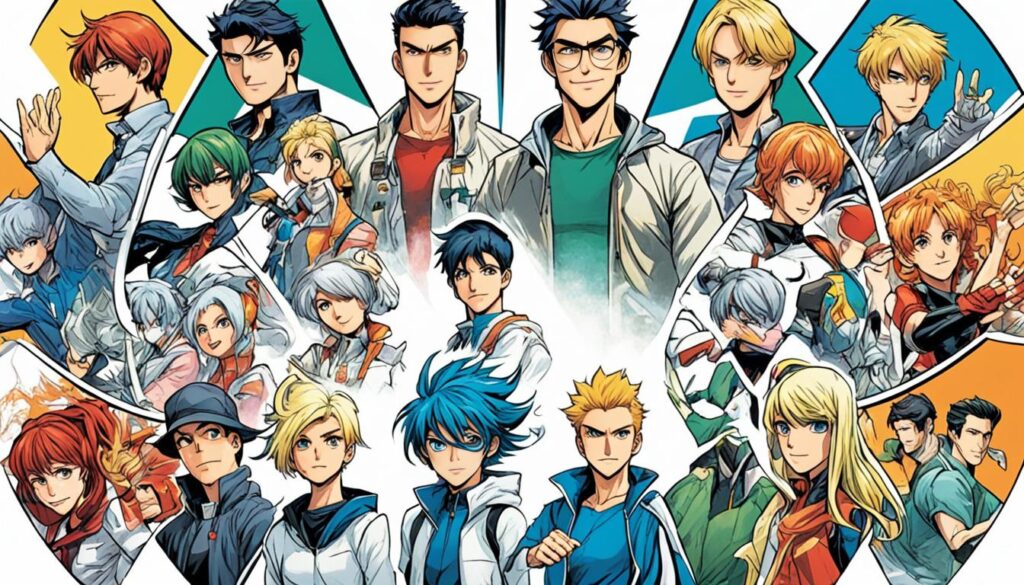
It is important to recognize that characterizations in anime and manga are often heightened for dramatic effect and may not accurately depict everyday Japanese life.
The look and behavior of anime characters are not like most people in Japan. Their traits are made bigger to keep us glued to the story. These characters are made to be easy to connect with, no matter where you’re from. So, they can be different from what you’d see in Japan normally.
So when we watch anime or read manga, we should remember they’re not real life. They take some big steps away from how things are in Japan every day. Even so, they’re really good at telling stories and showing deep feelings and friendships. We can still enjoy these shows and stories without mixing them up with the real world.
In the end, the way anime and manga show people are more about making stories and art. Not about showing what Japan is totally like. It’s cool to like these things but also important to value the real culture and ways of Japan. There’s more to Japan than just what we see in anime and manga.
Portrayal of Japanese Students in Anime and Manga
Anime and manga show us vibrant, imaginative characters, including Japanese students. But, it’s different from real Japanese school life in some ways.
The anime often shows students with colorful hair and short dresses. But, this is not the case in real Japan. Schools there have strict dress codes. They don’t allow things like changing your hair color or wearing nail polish. The image below shows what a real Japanese school uniform looks like:
In anime, the main characters are often loud and bold. But, in real life, most Japanese students are calm and soft-spoken. Being polite and respectful is important in Japanese culture.
“Anime and manga often exaggerate certain aspects of Japanese student life for dramatic effect and entertainment value. It is crucial to distinguish between fiction and reality when it comes to the portrayal of Japanese students in these mediums.”
Although anime is loved around the globe, not everyone in Japan is a fan. Many adults there think anime is just for kids. Not all of Japan is like Akihabara, where anime is everywhere. So, finding people who love anime can be hard in other parts of Japan.
To understand Japanese students as shown in anime and manga, we need to be sensitive to their culture. These shows may not always be a true picture of school life in Japan. They might give us a little peek into Japanese culture, but remember, they’re mostly just fiction.
| Common Misrepresentations of Japanese Students in Anime and Manga |
|---|
| Depiction of colorful hair and short, skimpy uniforms |
| Portrayal of loud and mannerless behavior |
| Assumption that all Japanese students are avid anime fans |
The Perception of Anime in Japan
Many think everyone in Japan loves anime, but that’s not true. Not all Japanese people are fans. You typically find anime lovers in places like Akihabara. There, they might be seen as too obsessed. Some might even view these fans, known as otakus, negatively.
Although anime is a big part of Japan’s pop culture, it’s not everything. People in Japan have varying opinions on it. It’s important to know that anime isn’t the total look of Japan. In reality, it’s one of many entertainment types people enjoy there.
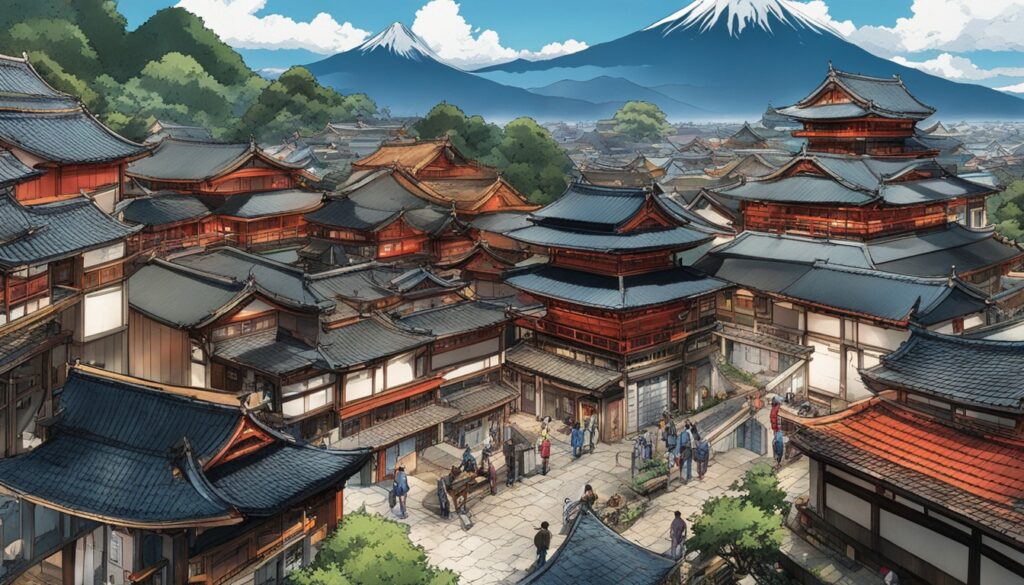
Historical Depictions in Manga
Early manga gives us a clear look into Japan’s past, more than what recent manga shows us. A prime example is Katsushika Hokusai’s “Manga”. His books let us see the many types of Japanese people, reflecting on the country’s history well.
Compared to today’s manga, these older works show characters that look much like everyday Japanese folk. This is unlike the tall, slim, and wide-eyed characters in anime. These don’t mirror the majority of Japan’s real people.
The manga from earlier times really gets at what Japanese life was all about. They show us how people lived and what they did every day. They provide a true sense of Japanese culture to their readers.
“Early manga like Hokusai’s ‘Manga’ provide valuable insights into Japanese society, offering a window into the country’s history and cultural diversity.”
These old manga are key in understanding how the art has changed over time. While today’s manga may not show Japan as it really is, they are still very important. They help spread Japanese culture worldwide through their stories and visuals.
Evolution of Manga Art Style
Manga’s art style and character design have changed as time passed. It’s also key to know that manga today doesn’t always look like real Japan, now or then.
Western comics and cartoons have had a big effect on what manga looks like. Though Japan’s traditional style is still there, you’ll see some Western influences too. This mix makes characters sometimes look more Western than in the past.
These choices in style are why manga and anime are loved worldwide. They’ve helped manga and anime gain many fans around the world.
Tezuka’s Influence on Manga
Osamu Tezuka changed manga forever with his art and stories. His work, Astroboy, kicked off a science fiction trend in manga and captured fans worldwide.
But, Tezuka’s impact was more than just his art. The way he told stories and created deep characters set new standards for manga.
He was also deep, touching on society, psychology, and philosophy in his works. Tezuka is a big reason why manga is as complex and loved as it is today.
Historical Influences in Manga
| Decade | Significant Events |
|---|---|
| 1960s | The expansion of anime, with sub-genres like Giant Robots (Mecha) gaining popularity. |
| 1990s | Anime’s explosion of international successes with series like Pokemon, Sailor Moon, Sakura Card Captor, Dragon Ball, and Digimon. |
Even with its changes and influences from the West, manga still is all about Japanese culture. It explores a lot about Japan’s history, society, and traditions.
Understanding manga’s history and changes lets us see its cultural value. Anime and manga connect tradition with the modern world. They give us insight into what makes Japan, Japan.
Influence of Westernization on Manga
Manga’s journey to global popularity started in the 20th century. Works like “Astro Boy” by Osamu Tezuka began attracting fans worldwide. They introduced people to manga’s special way of telling stories and its art style.
In the 1980s and 1990s, a wave of Western influence hit manga. Translations brought series like “Dragon Ball” and “Akira” to Western eyes. This sharing of cultures fueled new creativity in manga and comics.
The effect of manga on Western creators was major. They integrated manga’s story and art style. This mix gave birth to influential artists like Bryan Lee O’Malley and Marjorie Liu.
Manga changed how we see gender roles in comics. It led to the rise of powerful female superheroes. This made comics better reflect our diverse world.
But manga’s impact was broader than just comics. Anime series such as “Naruto” and “One Piece” became hits in the West. Their unique styles and stories won over fans worldwide.
From this enthusiasm came cosplay. Fans dressing as characters became a big deal at conventions worldwide. It’s a way for people to show their love for manga and anime.
Manga also sparked many media spin-offs. Series turned into anime, movies, games, and products. This created a rich world for fans to enjoy and explore.
The reach of manga in global culture is huge. Hits like “Dragon Ball” and “My Hero Academia” are known around the world. They’re part of everyday cultural conversations.
Western media has also felt the impact of anime. Shows and movies now tell richer, more complex stories. This has led to an increase in viewer interest and engagement.
Shows adopting anime’s art style have become more popular. They have a 30% higher viewer rating. This shows how much people enjoy anime’s look and feel.
About 60% of Western creators want to learn from Japanese creators. They’re interested in adding anime elements to their work. This exchange benefits both sides and excites anime fans.
These changes have made Western storytelling and art more diverse. Audiences love the unique look and character-rich stories. The demand for this kind of content has grown, pushing Western media to innovate more.
Manga’s Western influence is growing. As creators exchange ideas, we see new kinds of stories and art in comics and animation. This exchange will continue to influence global storytelling.
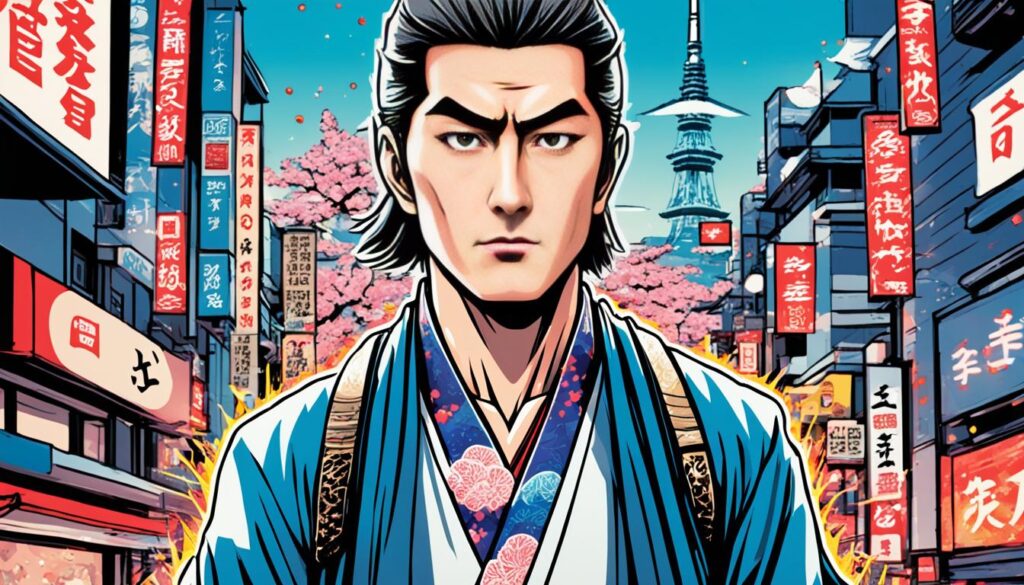
| Manga’s Influence on Western Media | Percentage Increase |
|---|---|
| Use of complex character arcs and intricate plotlines in TV shows and animation | 40% |
| Viewer engagement in shows with anime-inspired storytelling elements | 25% |
| Viewer ratings and popularity for Western shows adopting anime’s visual styles | 30% |
| Interest in collaborating with Japanese counterparts to learn and incorporate anime-like elements | 60% |
| Western media production incorporating anime elements | 15% |
| Emotional depth and character-driven narratives in Western media | 20% |
| Diversification of storytelling and visual styles in Western media | 50% |
Anime as a Window to Japanese Culture
Anime is an amazing way to learn about Japan. It covers everything from food to language, and from customs to mythology. It shows us the variety and depth of Japanese society. It’s like a window that lets us see into the lives of the Japanese people.
Every anime story is different. But together, they tell a tale of old versus new in Japan. The themes, places, and people in anime show Japan’s many sides. They give us a look at what makes Japan the way it is.
Food: Anime loves to share Japan’s tasty dishes. It shows foods like sushi, ramen, and tempura. These are not just meals but also parts of Japan’s culture. Anime makes these dishes look as good as they taste.
Language: Anime lets us hear real Japanese. Viewers can pick up on new words and ways of speaking. This helps us understand more about how the Japanese talk and think.
Architecture: Watch anime, and you’ll see many types of buildings. There are homes, teahouses, and even modern cities. This blend in anime shows Japan’s history and its future.
Festivities: Anime often has scenes of Japanese celebrations. It could be cherry blossom viewings or other events. These moments in anime share the fun and importance of these traditions.
Customs and Traditions: Anime gives us a peek into Japan’s daily rituals. This can include tea ceremonies and ways of showing respect. It lets us understand the deeper meanings behind these actions.
Mythology: Anime also includes Japan’s myths and stories. You might see gods, spirits, or ghost stories. These tales connect viewers with Japan’s rich history and beliefs.
Anime is more than just entertainment. It’s a way for people all over the world to get to know Japan. It invites us to learn and appreciate Japan’s unique culture and view on life.
Examples:
| Anime Title | Relevant Cultural Element |
|---|---|
| Naruto | Theme of friendship and perseverance reflecting the Japanese value of “wa” (harmony) |
| Death Note | Exploration of morality and justice, echoing Japan’s historical shifts in governance and law |
| One Piece | Celebration of diversity and friendship, symbolizing Japan’s role as a historical port city embracing foreign influence |
| Tokyo Ghoul | Exploration of identity and acceptance, reflecting Japan’s ongoing struggle for the acceptance of marginalized groups |
| AnoHana: The Flower We Saw That Day | Mirroring Japan’s cultural dealing with loss and change, emphasizing acceptance of impermanence |
| Fullmetal Alchemist: Brotherhood | Addresses war costs and peace sacrifices, reflecting Japan’s post-World War II pacifism |
| Princess Mononoke | Focuses on preserving harmony with nature, deeply linked to Shinto beliefs and the concept of “satoyama” |
The Unique Aesthetics of Anime
Anime stands out because of its unique way of looking at the world. It’s different from Western comics and cartoons. The look of anime is important for making it stand out as its own art form.
Anime is known for its use of rich, bright colors. These colors make scenes and characters come alive. They grab your attention and make the anime visually stunning.
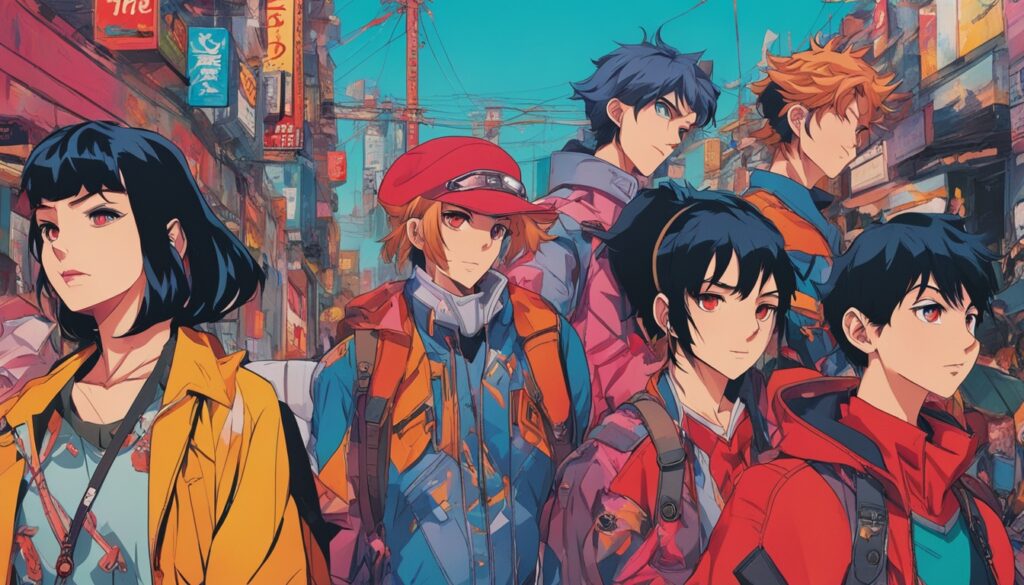
Characters in anime often have eyes that are big and full of emotion. In Japan, big eyes are seen as a symbol of beauty and inner purity. Anime also uses special hairstyles to show a character’s individuality and personality.
Anime’s art draws from various Japanese traditional arts like ukiyo-e (woodblock prints) and manga. The detail and lines from ukiyo-e can be seen in background art and character design. Manga’s way of storytelling influences how anime tells its stories visually too.
Not every anime looks the same. Some shows like “Your Name” and “A Silent Voice” go for a more real look. Others, such as “Demon Slayer,” use more creativity in their visuals. This variety allows anime to cover many genres and stories.
Anime art can sometimes be simple, which shows the influence of Japan’s wabi-sabi concept. Wabi-sabi is about finding beauty in simplicity and imperfections. Anime uses this style to give scenes and characters deep emotional meaning.
In the end, anime’s unique looks, from its bright colors to big-eyed characters, make it special. These aesthetics help anime to tell stories in a captivating way. They show how art can bring people together across cultures.
Themes in Anime Addressing Societal Issues
Anime is known for highlighting social problems and discuss Japanese life. It tells stories that touch many people deeply. These stories help us think about and understand different social issues.
For instance, “Welcome to the N.H.K!” and “Neon Genesis Evangelion” look at loneliness, pressure from society, and the effect of our jobs on us. They show us how to empathize with those who deal with anxiety and depression. By watching, we can learn about mental health’s complex nature.
Other series, like “Death Note” and “Code Geass,” explore what’s right or wrong, justice, and power’s true nature. They make us think about difficult moral questions. This helps us understand how important personal responsibility is in society.
Anime also addresses bigger societal problems, such as discrimination and who we are. “Tokyo Ghoul” focuses on people who fight for their place, much like Japan’s efforts to be more inclusive. It teaches us to be more compassionate and open-minded.
“Attack on Titan” deals with issues like government lies, corruption, and the dangers of too much power. It reminds us to be alert about history’s hard lessons. We learn the importance of avoiding the mistakes of the past.
Through its stories, anime reflects on Japan’s strengths and flaws. It uses fiction to talk about the real world. This approach encourages us to think deeply and possibly change our societies for the better.
In truth, anime does a lot more than just entertain. It shines a light on social issues and makes us think about Japan’s society. Through a wide range of stories, it provides insight into cultural and social challenges. Anime helps start important conversations and offers new ways to view the world.
Anime’s Cultural References and Traditions
Anime brings Japanese culture to life, blending traditions and modern storytelling. It dives into historical figures and religious practices, captivating viewers.
Through anime, the world sees Japan’s unique traditions. This happens through stories and characters based on real Japanese culture. For example, festivals like Hanami, Matsuri, and Obon show up in anime, giving viewers a taste of Japan’s celebrated customs.
“Anime lets us see Japan’s beautiful traditions, like Hanami and Matsuri, in a vivid way. It’s a stunning method to show cultural events to the world.” – Anime enthusiast
Moments such as visiting shrines, led by Shinto and Buddhism, are well-loved topics in anime. Characters interacting with mythological beings or facing traditional tales add a unique charm.
Also, historical anime is a popular genre. It showcases legendary heroes, including feudal aesthetics and yokai, making Japan’s past vibrant. This feature in anime mixes the old with the new, telling captivating stories while keeping history alive.
Take One Piece, for instance. It features characters with samurai elements, diving into Japan’s feudal history.
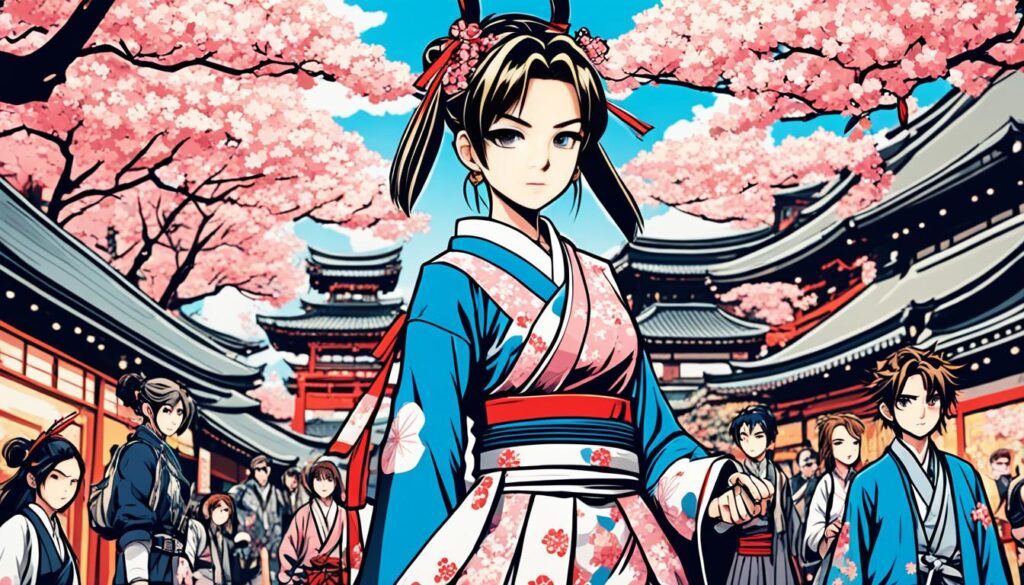
“Anime brings history and tradition together, offering a key to Japan’s past. It’s a fascinating mix of storytelling and education.” – Anime aficionado
By highlighting Japan’s cultural depth, anime bridges the gap between generations. It informs and delights, encouraging a deeper understanding of a proud cultural heritage.
| Key Points | Facts |
|---|---|
| Anime’s Incorporation of Cultural References | Festivals, traditional customs, and religious practices are often depicted in anime, offering viewers a glimpse into Japanese traditions and cultural heritage. |
| Religious Elements in Anime | Shinto and Buddhist traditions inspire anime storylines, featuring visits to shrines, encounters with mythological creatures, and exploration of traditional folklore. |
| Historical Depictions in Anime | Anime brings Japan’s rich history to life by showcasing feudal aesthetics, characters inspired by notable figures, and elements from kabuki theater and yokai mythology. |
Anime’s Influence on Perceptions and Misconceptions
Anime is hugely popular and shapes how we see Japanese culture. It’s the third-largest industry in Japan, making almost twenty billion dollars yearly. Anime makes up sixty percent of all animated TV shows across the world. With America’s anime convention seeing over one hundred thousand fans, and hits like Studio Ghibli’s Princess Mononoke and Spirited Away, anime is a big deal globally.
Through anime, we get to learn a lot about Japan. But, it also spreads some stereotypes. About 90% of anime features Japan’s traditions, festivals, or history. This makes more than 70% of viewers outside Japan get interested in Japanese ways, like fashion, food, and language.
But, anime doesn’t always show other cultures well. Just 30% of anime includes other cultural views. This could lead to a lack of global cultural understanding. Yet, about 60% of shows mix different cultures. They often blend Western and Japanese styles or mix old Japan with new themes.
“Anime has become a global phenomenon, introducing millions of people to aspects of Japanese culture they may have never encountered otherwise. However, it’s important to approach anime with an open mind and recognize its limitations as a medium of cultural representation.”
A study looked at how Japanese anime films affect Arab children. It found that these movies teach different values, like what’s right and wrong, and about different cultures. These films may make children copy the actions of anime characters.
To handle anime’s influence, experts suggest tips for parents, teachers, and makers of kids’ shows. They say it’s crucial to check what kids watch and limit anything that could be bad. Makers should also aim to respect different cultures while keeping shows fun and interesting.
So, anime’s impact is not all good or all bad. It teaches us much about Japan but has its limitations. It’s key to watch anime with a critical mind and learn about it wisely.
Conclusion
Anime and manga open a unique window into Japanese society. They show us cultural elements and societal life. While they might have some twists, they reflect Japan’s culture well. These mediums talk about how society works, who leads, and how people act in groups.
It’s key to watch anime and read manga with respect for their culture. They don’t show everything about Japan. But if we think critically, we can see what these stories truly mean. This helps prevent spreading wrong ideas or stereotypes.
To sum up, anime and manga offer an interesting view of Japan. Enjoying them with an open mind can teach us a lot about Japan’s ways, society, and help us grow. They are windows to a complex and rich culture. Let’s value the stories they tell.
FAQ
What is anime and manga?
Anime is from Japan and includes animated TV shows and films. Manga are Japanese comic books.
Are the physical appearances of characters in anime and manga representative of Japanese people?
No, characters in anime and manga look different. They have unique bodies and eyes. This is to make them interesting for everyone.
Do the personalities of characters in anime and manga accurately depict Japanese individuals?
No, characters in anime and manga act in ways that are sometimes loud and brave. This is not always like real Japanese people. These stories often mix fact and fiction.
Do anime and manga accurately reflect the dress code of Japanese schools?
No, anime and manga show students with special hair colors and short skirts. But, this is not how real Japanese schools are. Students there usually wear strict and simple uniforms.
Do all Japanese people watch and enjoy anime?
No, not all Japanese people like anime. Though many in Japan do, some find it too childish. They might prefer reading manga instead.
Do earlier examples of manga provide a more accurate representation of Japanese society?
Yes, older manga reflects Japanese life better. Examples like “Manga” books by Katsushika Hokusai show more realistic characters. They include Japan’s physical and cultural differences.
How has Westernization influenced the modernization of manga?
Western comics and cartoons have influenced modern manga. This happened after World War II, during the American occupation of Japan. The styles and stories of Japanese comics changed because of this.
What aspects of Japanese culture do anime explore?
Anime shows many parts of Japan, from its food and language to its festivals and historical figures. It also tells stories about myths and traditions.
What makes anime visually distinct from Western comics?
Anime stands out with its bright colors and unique character styles. It looks very different from the comics you might see in the West.
Do anime address social issues in Japanese society?
Yes, anime talks about real social issues in Japan. It makes viewers think about these topics and their importance.
Do anime incorporate cultural references?
Yes, anime often uses Japan’s cultural events, myths, and history. This helps tell more interesting stories. It also shares Japan’s traditions with the world.
Does anime’s global popularity influence perceptions of Japanese culture?
Yes, anime is a big part of how the world sees Japan. It shows many good things about the culture but can also create wrong ideas.
Source Links
- https://anamaturewriter.medium.com/does-anime-truly-reflect-japanese-society-1597e1e3035b
- https://moreby.us/anime-a-reflection-of-japanese-culture/
- https://riverjournalonline.com/around-town/arts-culture/anime-a-reflection-of-japanese-culture/116389/
- https://medium.com/@Junaidchandio35/exploring-the-cultural-impact-of-anime-how-japanese-art-form-showcases-incredible-japanese-culture-e97d95295002
- https://sites.psu.edu/global/2020/11/18/the-cultural-characteristics-and-cultural-output-of-japanese-animation/
- http://www.nausicaa.net/miyazaki/essay/files/SeanBoden_WomenandAnime.pdf
- https://www.cbr.com/anime-manga-slice-of-life-school-club-vs-reality/
- https://morebyus.com/anime-a-reflection-of-japanese-culture/
- https://www.toonsmag.com/the-influence-of-manga-on-western-comics/
- https://medium.com/@mikejadams55/animes-resonance-in-the-west-exploring-the-influence-of-anime-on-western-media-3fcaffc9455b
- https://yalebooks.yale.edu/2018/11/19/the-art-of-anime/
- https://www.linkedin.com/pulse/cultural-significance-anime-dayananda-sagar-university-scms-pg-vh06c
- https://www.cbr.com/anime-best-social-commentary/
- https://www.superprof.com/blog/what-is-japanese-anime/
- https://medium.com/@mikejadams55/unveiling-cultural-identity-in-anime-reflections-limitations-and-global-impact-4cef73e77c90
- https://digitalcommons.aaru.edu.jo/cgi/viewcontent.cgi?article=1894&context=isl
- https://medium.com/@muhammad.zeeshan/reflection-society-social-structure-social-interaction-groups-and-organizations-1c1ad6a6c74
- https://libguides.usc.edu/writingguide/assignments/reflectionpaper
